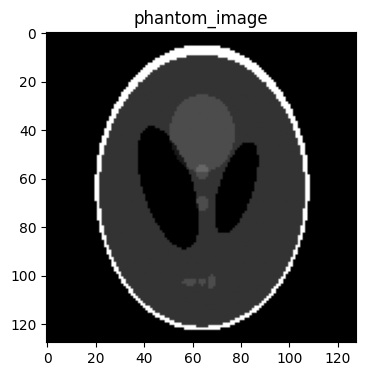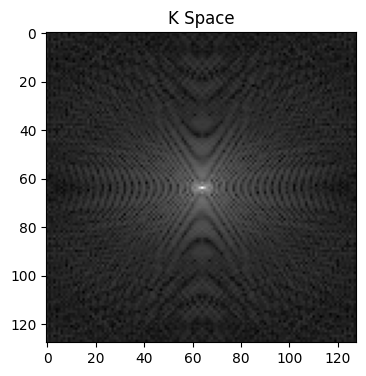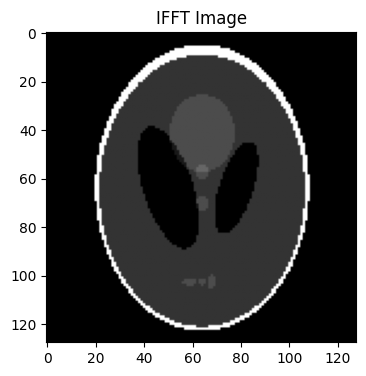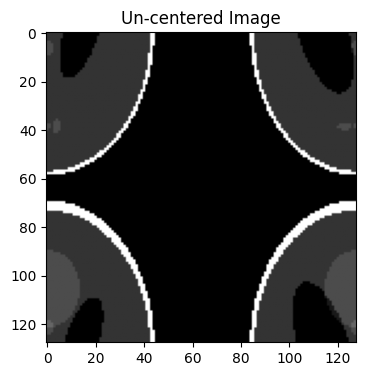bart fft#
=================================================================================================================
The bart fft command in BART command performs a Fast Fourier Transform (FFT) along selected dimensions of input data.
Where we can view the full usage string and optional arguments with the -h flag.
!bart fft -h
Usage: fft [-u] [-i] [-n] bitmask <input> <output>
Performs a fast Fourier transform (FFT) along selected dimensions.
-u unitary
-i inverse
-n un-centered
-h help
Mathematical Formulation#
Standard Forward FFT#
For an input signal \(x(n)\), the discrete Fourier transform (DFT) is:
where:
\(x(n)\) is the input data.
\(X(k)\) is the FFT output.
\(N\) is the length of the transformed dimension.
Inverse FFT (-i Option)#
The inverse FFT (IFFT) transforms frequency-domain data back into the time/spatial domain:
Applying bart fft -i computes this inverse transform.
k-space to Image Domain: In MRI, data is initially acquired in k-space, which is the spatial frequency domain. To reconstruct an image, an inverse FFT is typically applied to the k-space data to transform it into the image domain.
Unitary FFT (-u Option)#
By default, the FFT scales the transformed values by N. The unitary FFT normalizes the result:
which ensures that applying fft followed by ifft returns the original signal without scaling.
Uncentered FFT (-n Option)#
The uncentered FFT (-n) performs a Fast Fourier Transform without shifting the zero-frequency (DC) component to the center. In standard FFT implementations, the output is usually shifted so that the low frequencies (including DC) are centered in k-space. Using -n keeps the DC component at its original location.
The frequency indices in the uncentered FFT (-n) are assigned sequentially:
Mathematical Interpretation of the Shift#
The FFT shift operation is mathematically represented by multiplying the input signal by a phase term:
This results in a frequency-domain shift:
Examples for 1D Array (Using Bash)#
FFT Numerical Comparison Chart#
Index |
Original Signal (x) |
Standard FFT (X_fft) |
Unitary FFT (X_fft_u) |
Uncentered FFT (X_fft_n) |
|---|---|---|---|---|
0 |
1.0 |
(-2 + 0j) |
(-1 + 0j) |
(10 + 0j) |
1 |
2.0 |
(2 + 2j) |
(1 + 1j) |
(-2 + 2j) |
2 |
3.0 |
(10 + 0j) |
(5 + 0j) |
(-2 + 0j) |
3 |
4.0 |
(2 - 2j) |
(1 - 1j) |
(-2 - 2j) |
Creates a 1D vector in BART and stores it in the variable x.#
!bart vec 1 2 3 4 x
!bart show x
+1.000000e+00+0.000000e+00i +2.000000e+00+0.000000e+00i +3.000000e+00+0.000000e+00i +4.000000e+00+0.000000e+00i
Example 1: Performs a Fast Fourier Transform (FFT) along the first dimension of the vector x and stores the output in X_fft.#
!bart fft 1 x X_fft
!bart show X_fft
-2.000000e+00+0.000000e+00i +2.000000e+00+2.000000e+00i +1.000000e+01-0.000000e+00i +2.000000e+00-2.000000e+00i
Example 2: Performs a unitary Fast Fourier Transform (FFT) along the first dimension of the vector and stores the output in X_fft_u#
!bart fft -u 1 x X_fft_u
!bart show X_fft_u
-1.000000e+00+0.000000e+00i +1.000000e+00+1.000000e+00i +5.000000e+00-0.000000e+00i +1.000000e+00-1.000000e+00i
Example 3: Performs a uncentered FFT along the first dimension of the vector and stores the output in X_fft_n#
!bart fft -n 1 x X_fft_n
!bart show X_fft_n
+1.000000e+01+0.000000e+00i -2.000000e+00+2.000000e+00i -2.000000e+00+0.000000e+00i -2.000000e+00-2.000000e+00i
Examples for image(Using Python)#
# Importing the required libraries
import numpy as np
import matplotlib.pyplot as plt
%matplotlib inline
import cfl
from bart import bart
phantom_image = bart(1, 'phantom -x 128') # Generate a phantom image with size 128x128
# Visualizing the image using Matplotlib
plt.figure(figsize=(4,6))
plt.imshow(abs(phantom_image), cmap='gray')
plt.title('phantom_image')
Text(0.5, 1.0, 'phantom_image')

Exmaple 4: Applying FFT along the first and second dimensions (transform from image domain to k-sapce data).#
kspace = bart(1, 'fft 3', phantom_image)
# Visualizing the image using Matplotlib
plt.figure(figsize=(4,6))
plt.imshow(abs(kspace)**.3, cmap='gray')
plt.title('K Space')
Text(0.5, 1.0, 'K Space')

Exmaple 5: Applying inverse FFT along the first and second dimensions (transform from k-space data to image domain).#
By -i
image = bart(1, 'fft -i 3', kspace)
# Visualizing the image using Matplotlib
plt.figure(figsize=(4,6))
plt.imshow(abs(image), cmap='gray')
plt.title('IFFT Image')
Text(0.5, 1.0, 'IFFT Image')

Exmaple 6: Applying un-centered IFFT along the first and second dimensions.#
By -in
image_n = bart(1, 'fft -in 3', kspace)
# Visualizing the image using Matplotlib
plt.figure(figsize=(4,6))
plt.imshow(abs(image_n), cmap='gray')
plt.title('Un-centered Image')
Text(0.5, 1.0, 'Un-centered Image')

